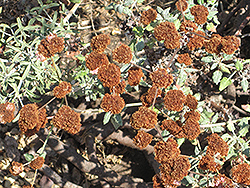It's all about ...
plants

Red Buckwheat
Eriogonum grande var. rubescens
Plant Height: 12 inches
Flower Height: 24 inches
Spread: 30 inches
Sunlight:
![]()
![]()
Hardiness Zone: 3a
Other Names: Rosy Buckwheat, San Miguel Island Buckwheat
Description:
An attractive plant for use in low maintenance landscaping or xeriscaping; a native perennial producing red to rose flowers above the foliage in late spring to early fall; excellent for naturalizing
Ornamental Features
Red Buckwheat features showy clusters of rose flowers rising above the foliage from late spring to early fall, which emerge from distinctive red flower buds. The flowers are excellent for cutting. Its tomentose pointy leaves are grayish green in colour. As an added bonus, the foliage turns a gorgeous orange in the fall.
Landscape Attributes
Red Buckwheat is an herbaceous perennial with a mounded form. Its medium texture blends into the garden, but can always be balanced by a couple of finer or coarser plants for an effective composition.
This is a relatively low maintenance plant, and is best cleaned up in early spring before it resumes active growth for the season. It is a good choice for attracting bees and butterflies to your yard, but is not particularly attractive to deer who tend to leave it alone in favor of tastier treats. It has no significant negative characteristics.
Red Buckwheat is recommended for the following landscape applications;
- Mass Planting
- Rock/Alpine Gardens
- Border Edging
- General Garden Use
- Groundcover
- Naturalizing And Woodland Gardens
Planting & Growing
Red Buckwheat will grow to be about 12 inches tall at maturity extending to 24 inches tall with the flowers, with a spread of 30 inches. Its foliage tends to remain dense right to the ground, not requiring facer plants in front. It grows at a medium rate, and under ideal conditions can be expected to live for approximately 10 years. As an herbaceous perennial, this plant will usually die back to the crown each winter, and will regrow from the base each spring. Be careful not to disturb the crown in late winter when it may not be readily seen!
This plant does best in full sun to partial shade. It prefers dry to average moisture levels with very well-drained soil, and will often die in standing water. It is considered to be drought-tolerant, and thus makes an ideal choice for a low-water garden or xeriscape application. It is not particular as to soil pH, but grows best in poor soils, and is able to handle environmental salt. It is highly tolerant of urban pollution and will even thrive in inner city environments. This species is native to parts of North America.


